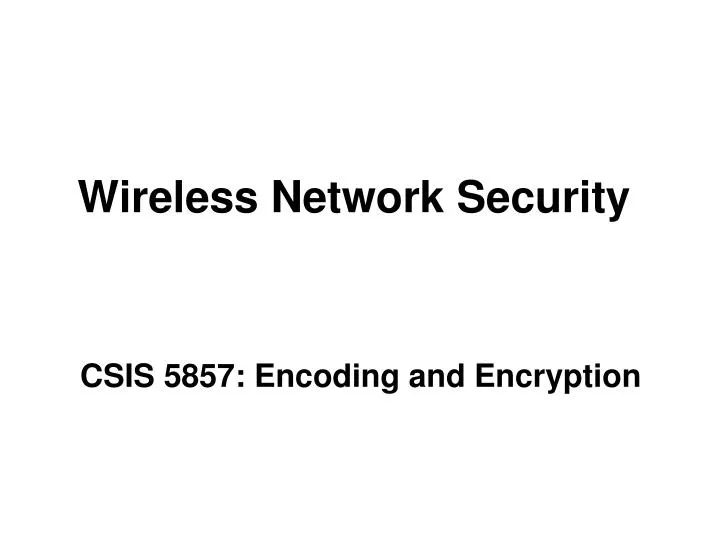

Wireless Network Security
Oct 22, 2014
270 likes | 643 Views
Wireless Network Security. CSIS 5857: Encoding and Encryption. Wireless LAN Structure. Wireless LAN Terminology. Station : Device capable of IEEE 802.11 wireless connectivity (wireless laptop, etc.) Distribution System : Backbone system for long-distance communication (lines/satellite/etc.)
Share Presentation
- authentication
- authentication protocol
- access point
- challenge response
- wireless network security
- generate pairwise master key

Presentation Transcript
Wireless Network Security CSIS 5857: Encoding and Encryption
Wireless LAN Structure
Wireless LAN Terminology • Station: Device capable of IEEE 802.11 wireless connectivity (wireless laptop, etc.) • Distribution System: Backbone system for long-distance communication (lines/satellite/etc.) • Access point: Bridge between station and distribution system (or between stations in same BSS) • Basic Service Set (BSS): Set of stations in range of access point
Wireless LAN Structure • Differences from LAN security: • Any transmission may be listened to by any device in range of access point All transmissions must be secured • Other wireless devices in range of AP can attempt to connect to it Any device wishing to communicate through access point must be authenticated
Authentication Server • Authentication server • Contacted by AP when station requests access • Uses authentication protocol to establish station identity
IEEE 802.11i Operation Phases
Discovery Phase • Station contacts AP and they pass identifiers • Station passes security suite to AP (like SSL) • AP responds with chosen algorithms
Authentication Phase • AP blocks communication with rest of network until authentication complete • AS performs all authentication functions • AP just passes data back and forth
Authentication Phase • Station sends request to AP for connection to authentication server • Extensible authentication protocol used for mutual authentication • AS generates keys for secure informationexchange
Authentication Phase • Extensible Authentication Protocol: • Based on challenge-response • Station and AS share secret information (such as symmetric key) • AS sends challenge to station (via AP) • Station sends response • May repeat with multiple challenges (10 – 20) for added protection against replay attacks
Key Management Phase • Possible methods: • Station and AP already share pre-shared key (PSK) previously installed on station • AS generates and sends master session key (MSK) to station as part of EAP challenge response • Used to generate pairwise master key
Key Management Phase • HMAC-SHA1 used to generate Pairwise transient key from • Pairwise master key • MAC address of station and AP (prevents replay attacks) • PTK consists of • Key used for confirmation of other keys • Key used to encrypt other keys • Actual temporal key used to securely transmit data
Key Management Phase • Handshake between station and AP used to establish and confirm keys used for secure transmission
Protected Data Transfer • Data transferred securely between station and AP • Keys generated by AS and passed to AP • Cipher suite agreed to in discovery phase
Wireless Application Protocol • Standards for connecting mobile devices (smart phones, tablets, etc.) to the Web • Requires secure connections between mobile devices and gateways to servers
Wireless TLS • Wireless version of Transport Layer Security protocol used for web communication • WAP end-to-end security: • TLS used between gateway and server • WTLS used between client and gateway
Wireless TLS • Basic stages of handshake similar to TLS/SSL
Wireless TLS • Secure message generation similar to TLS/SSL
History • 802.11b first broadly accepted standard • Goal: Insure interoperability of devices • Wireless Ethernet Compatibility Alliance (WECA) industry consortium formed 1999, later renamed Wi-Fi (Wireless Fidelity) Alliance • created a test suite to certify interoperability • initially for 802.11b, later extended to 802.11g
History • Original 802.11 spec had security features: • Wired Equivalent Privacy (WEP)algorithm • major weaknesses found • 802.11i addressed WLAN security issues • Wi-Fi Alliance Wi-Fi Protected Access (WPA) • final 802.11i Robust Security Network (RSN) • Wi-Fi Alliance certifies vendors in compliance with 802.11i specification under the WPA2 program.
802.11i RSN Services • Access control: • Preventing access toaccess point until authentication • Authentication: • Mutual authentication between stations and access points, and key generation • Privacy: • Encrypting/hashing/etc. of messages to insure confidentiality/information integrity/etc.
- More by User

Wireless Network Security: NoCat
But you may ask, what security measures NoCat has added to our wireless network! ... Wireless Network Security: NoCat. NoCat, mainly will only give the ...
662 views • 16 slides
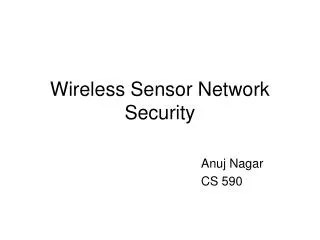
Wireless Sensor Network Security
Wireless Sensor Network Security. Anuj Nagar CS 590. Introduction. Typical Wireless Sensor Network (WSN). Need for security. WSNs are becoming a cost effective, practical way to go about deploying sensor networks.
652 views • 16 slides
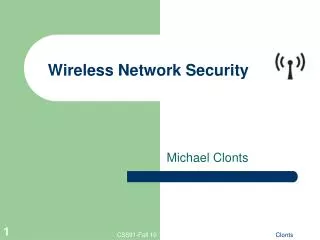
Wireless Network Security. Michael Clonts. Agenda. Will discuss: Home wireless configuration Public hotspot security Will not discuss: Nuts and bolts of wireless security. Home Wireless. You’ve bought a wireless router… now what?. Home Wireless – Basic Security.
296 views • 11 slides

Wireless Network Security. Why wireless?. Wifi , which is short for wireless fi … something, allows your computer to connect to the Internet using magic. -Motel 6 commercial. … but it comes at a price. Wireless networks present security risks far above and beyond traditional wired networks.
520 views • 31 slides

Wireless Network Security. Cable Modem. Premises- based. Access Networks. LAN. Transit Net. LAN. LAN. Private Peering. Premises- based. Core Networks. Transit Net. WLAN. WLAN. NAP. Analog. WLAN. Transit Net. Public Peering. DSLAM. Operator- based. RAS. Regional.
462 views • 30 slides

Wireless Network Security. TJX Data Breach. TJX used WEP security They lost 45 million customer records They settled the lawsuits for $40.9 million. Objectives. Describe the basic IEEE 802.11 wireless security protections
764 views • 55 slides

FORE SEC Academy Security Essentials. Wireless Network Security. Objectives. Learn how wireless networks are used Wireless architecture and protocols Common misconceptions Top 5 security risks Steps to planning a secure WLAN. Popular Wireless Devices.
1.82k views • 19 slides
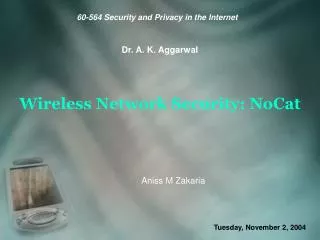
Wireless Network Security: NoCat. 60-564 Security and Privacy in the Internet. Dr. A. K. Aggarwal. Aniss M Zakaria. Tuesday, November 2, 2004. Wireless Network Security: NoCat. Agenda:. Introduction Securing Wireless Network NoCat What is NoCat? Installation Testing Conclusion.
302 views • 16 slides
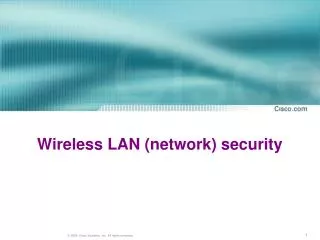

Wireless LAN (network) security
Wireless LAN (network) security. Wireless security. - Is the process of preventing unauthorized access or damage to computers (damage data or damage application) using wireless network . - WLAN vulnerabilities: 1- Weak device – only authentication 2- Weak data encryption
295 views • 11 slides

Wireless Network Security. Guilin Wang The School of Computer Science 19 March 2008 ( L21 ). Outline. Wireless Network Wireless Network Security - WEP - WPA=WEP2 - WPA2. 1. Wireless Network.
632 views • 19 slides

Wireless Network Security. Raj Jain Washington University in Saint Louis Saint Louis, MO 63130 [email protected] Audio/Video recordings of this lecture are available at: http://www.cse.wustl.edu/~jain/cse571-11/. Overview. IEEE 802.11 Wireless LAN Overview Legacy 802.11 Security: WEP
756 views • 32 slides

Wireless Network Security. TJX Data Breach. TJX used WEP security They lost 45.7 million customer records They settled the lawsuits for $40.9 million. Objectives. Describe the basic IEEE 802.11 wireless security protections
743 views • 56 slides

Wireless Network Security. Dr. John P. Abraham Professor UTPA. 802.11 Protocols. 802.11-1997 (802.11 legacy) 1997 up to 2Mbps. Used 2.4Ghz band 802.11a Theoretically 20Mbps, but could not penetrate walls, practically yielded 1Mbps. Used 5GHz band. 50’ 802.11b 1999. 5Mbps. 375’ used 2.4GHz
224 views • 11 slides

Wireless network security
Lt. Robert Drmola, University of defence, Communication and information system department. Wireless network security. Content. Home and corporal networks comparison Data protection Protection methods WLAN standards comparison Conclusion. Home versus organizations networks.
383 views • 18 slides

Wireless Network Security. By Simon Langford. About…. This oral presentation is on wireless networks and the methods of security in use on them, in order to prevent un-authorized access to the network.
276 views • 10 slides

WIRELESS NETWORK SECURITY
WIRELESS NETWORK SECURITY. Objective. Understand basic wireless technology Understand the components of wireless network and implement a wireless network Build a wireless LAN Understand the security issues of wireless network
1.07k views • 68 slides

WIRELESS NETWORK SECURITY. Hackers. Ad-hoc networks War Driving Man-in-the-Middle Caffe Latte attack. AD-HOC networks. WAR DRIVING. Searching for Wi-Fi by person in moving vehicle. MAN-IN-THE-MIDDLE. Hotspots have little security
401 views • 26 slides
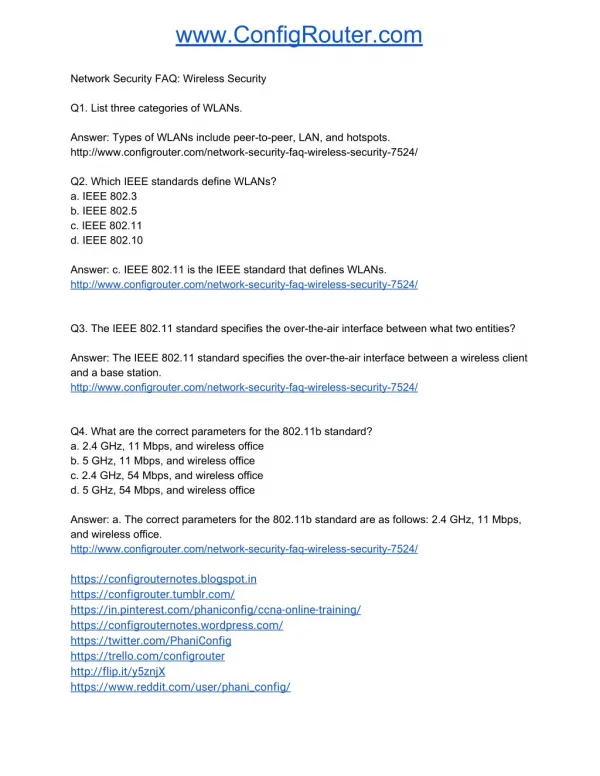
Network Security FAQ Wireless Security
74 views • 4 slides

Wireless Network Security Market
Wireless Network Security Market categorizes the Global Market by Solutions as Firewall, IPS/IDS, Encryption, I&AM, UTM, Services as Security Operations, Consulting, Managed Security Services & by geography
103 views • 8 slides

Wireless Network Security. Wireless Security Overview. concerns for wireless security are similar to those found in a wired environment security requirements are the same: confidentiality, integrity, availability, authenticity, accountability
363 views • 26 slides

Wireless Network Security. Wireless networks are “just like” other networks Except . . . Almost always broadcast Generally short range Usually supporting mobility Often very open. Types of Wireless Networks. 802.11 networks Variants on local area network technologies Bluetooth networks
269 views • 18 slides
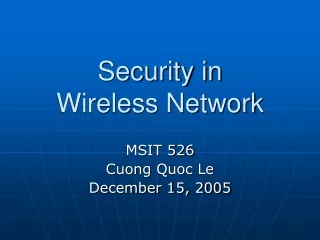
Security in Wireless Network
Security in Wireless Network. MSIT 526 Cuong Quoc Le December 15, 2005. Overview. Popularity of Wireless Networks Benefits of Wireless Networks Vulnerabilities in Wireless Networks Some solutions to enhance security in wireless networks. Popularity of Wireless Networks.
228 views • 14 slides
